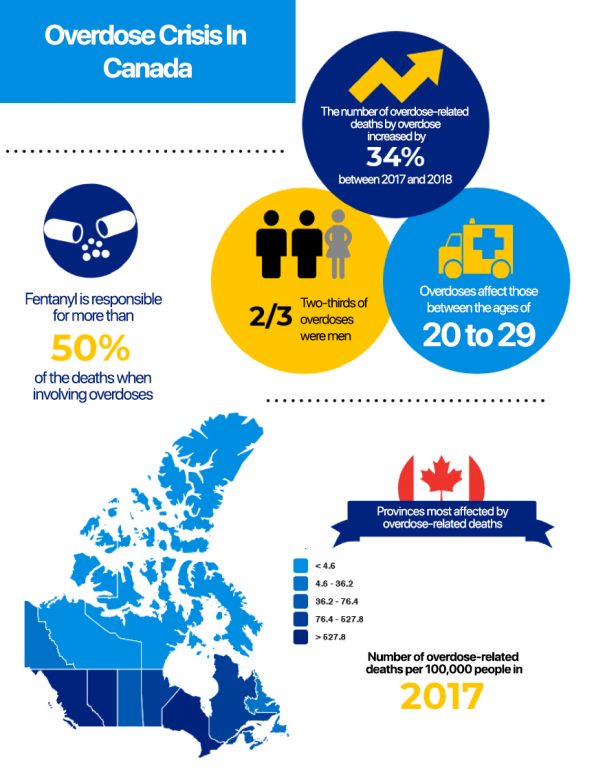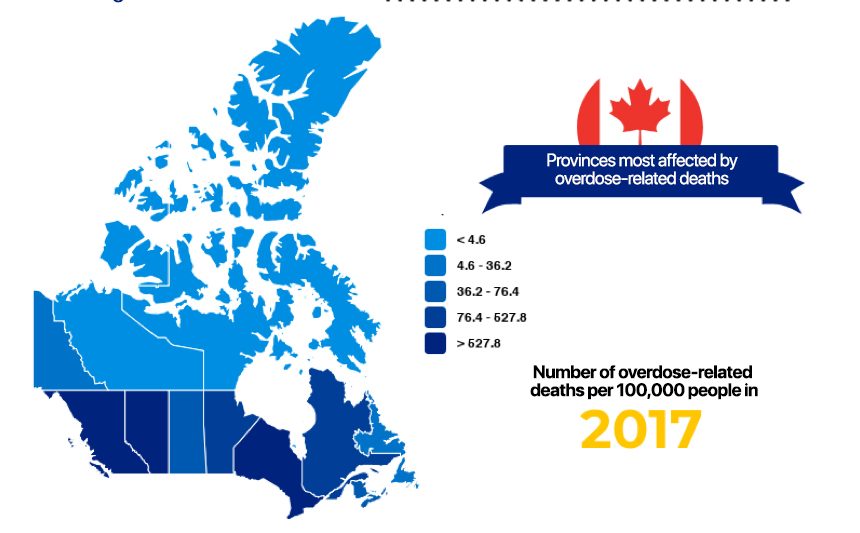Canada is currently experiencing an alarming opioid crisis, which is on the rise. It has been noticed that there has been a substantial increase of overdose-related deaths in many provinces over the past year. In Canada, this crisis has had devastating effects on family and friends.
Context and Key Figures
As per a report published in June 2018 by the Public Health Agency of Canada[1], Canada has experienced an increase of 34% of deaths potentially being linked to drug overdoses. In 2017, there were 3,987 deaths linked to the use of opioids in Canada, which represents 11 lives lost per day. These overdose-related deaths are primarily linked to men (78%), aged 20 – 29 years of age (28%). And there are disparities that can be seen between different regions. Western Canada, such as British Columbia, was the hardest hit, while Québec, Ontario and the Atlantic regions have also experienced a considerable increase this year. In 2017, opioids caused more deaths than road accidents[2].
Primary Reasons
Since June 2017, there have only been statistics kept for Montreal, in which 95 deaths were related to excessive drug use. Seeing as these deaths are at the forefront, the police force and the first responders are sounding the alarm about the potency of these new drugs on the market. On top of being easily accessible, notably for youth, the drugs are often cut with other synthetics, which ravage the body. At the heart of it all, fentanyl is currently the new hot ticket item. It exists as pills, powders and as patches, in addition to being injectable. Fentanyl is 40 times stronger than heroin and 100 times stronger than morphine. Four (4) granules of pure fentanyl salt, about 2 mg, can be enough to kill the average adult according to the Royal Canadian Mounted Police. This drug alone is responsible for more than 50% of the deaths when involving opioid overdose in Canada.
Measures Put in Place
The Canadian opioid crisis has brought to light a serious problem regarding funds allocated to the care and treatment of those suffering from drug addiction. Moving forward, the provincial governments are looking to free up funds that will be used to fight the crisis.
In Québec, the government has decided to support reintegration programs and vocational training, which can prevent and help treat addictions. This initiative is necessary as a result of the current situation concerning opioid abuse. With this, it was also decided that naloxone should be made available in all pharmacies and community centers. Naloxone temporarily interrupts the effects of the opioids in overdose victims. The problem is that a training is required to administer naloxone. This said, prevention as well as help for those suffering from dependencies must be at the heart of the solution in order to improve the ongoing crisis.

[1] https://www.canada.ca/en/public-health/services/publications/healthy-living/national-report-apparent-opioid-related-deaths-released-june-2018.html
[2]Optima Project: CRCHUM (CHUM Research Center)
Read: International Day Against Drug Abuse and Illicit Trafficking






Jeff Bugs
You should put teen death rates
Nancy O"Connor
Seniors appear to be the ones suffering the most from the opioid crisis. They are prevented from getting opioids which they have been taking for the last 10 or 15 yrs when they were prescribed to give patients relief while they waited 1-2 yrs. for hip or knee replacement. Seniors are most likely to follow Dr. instructions and not abuse medication . This is very difficult for seniors who are now being told to use cannabis not covered by drug benifit and could cost over 200:$ a month that most seniors cannot afford.Opioids are covered and a prescription costs between 4&6$ a month If they have cancer pain no problem arthritic and other pain are not . This is not fair